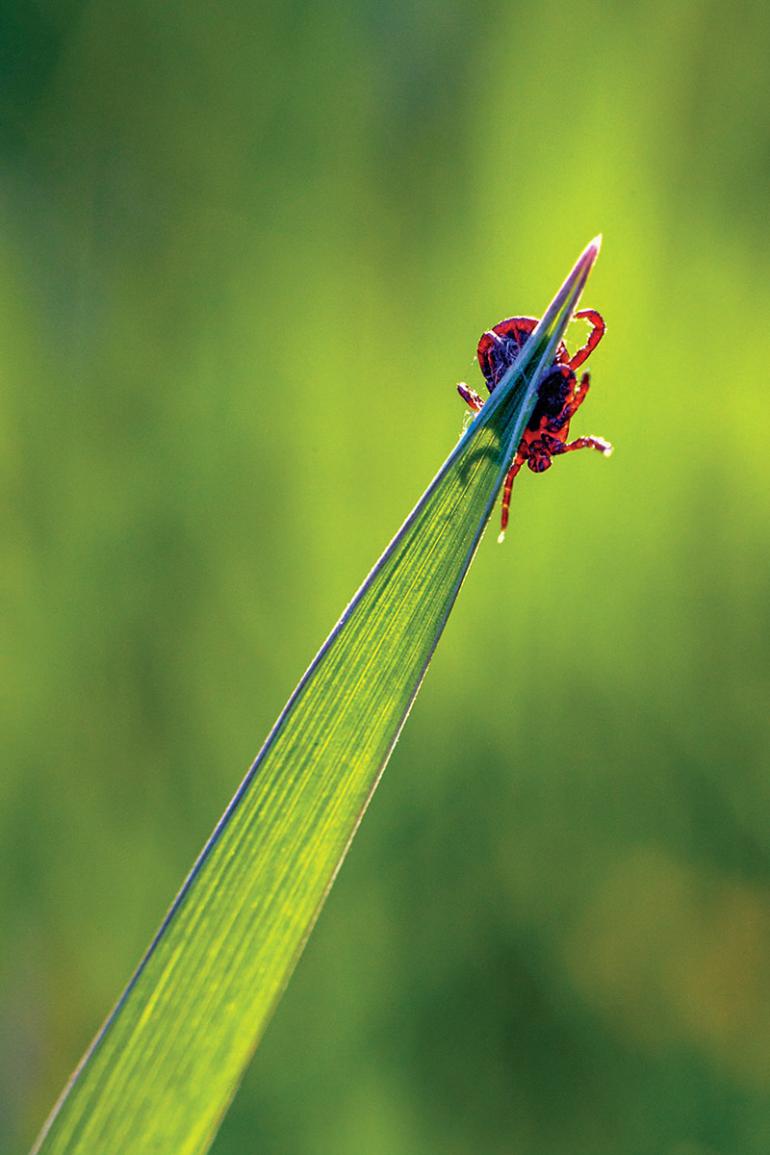Ticked Off
An arachnid assault.
After a never-ending April drizzle, lingering snowstorms, and persistent cold, I welcomed an invitation from a friend in early May. “I know the perfect spot for a spring hike,” he told me.
And so we headed for Storm Castle. His theory was that the south-facing slope would be generally free of snow and mud, and other hikers would be minimal or even absent. The short, steep trail promised to be ideal for an early-season conditioning hike.
Although the air was cool, the sun felt good as we ascended, and we were glad we’d left our jackets in the truck. The exertion alone had us plenty warm. We frequently turned to look around and take in the scenery—dry grass and shrubs close by, snow on distant mountaintops. We were making good time. What a great day.
The instant they were on us, they started climbing. Their little tick-legs churned and picked up pace, like rock climbers in a speed competition.
We weren’t worried about grizzlies, so didn’t give a second thought to potential threats. What we should have realized, though, was that bears aren’t the only critter to emerge in the spring. And one such critter is also plenty hungry for blood: the tick. Like leeches and vampires, these blood-sucking vermin make a person cringe.
We hadn’t traveled far when I glanced at my friend. “What’s that?” I asked. A black speck on his light-colored shirt had caught my attention. The odd thing about this speck was that, like us ascending the mountain, this little bugger was going straight up. I flicked him off, my buddy thanked me, and like Lewis & Clark, we proceeded on. A short time later, I discovered a tick about thigh-high on my pant leg. We stopped and took a tick inventory: two or three ticks each. Not good.
I couldn’t figure it out. I’d always heard that ticks hung out on overhanging branches, and when you unsuspectingly strolled along, they dropped on you with malignant intent in their evil little hearts. A Top Gun dive-bomb straight for your hair. That’s what we were told, at least. But we were in the open, with no overhanging limbs, so the menacing devils must have had a different modus operandi for latching on to us humans.
We decided to do some sleuthing. I watched my buddy walk in front of me, and almost like magic, a tick appeared on his pant leg, at about knee-height. We soon discovered that there were ticks stuck to the end of many blades of the tall grass. We could wave our hands or walk within a sixteenth-of-an-inch of these guys, and nothing happened. But, should we brush against the blade, no matter how gently, the little fellas jumped. And the instant they were on us, they started climbing. Their little tick-legs churned and picked up pace, like rock climbers in a speed competition. We repeated the experiment several times, and invariably, when we tickled the grass, a tick at the end of a stalk made the leap and began its hitchhike.
As we continued our climb, we were careful to steer clear of the grass that curved over the trail. We found only a tick or two as we continued, brushing them off as needed. We thought it was an amusing annoyance.
I took off my shirt and discovered my skin dotted with ticks.
At the summit, I pondered our rewarding uphill climb, and the uphill trajectory of the ticks as well. I told my companion to hold up a minute before we started down. He was wearing a shirt with a collar, and I wondered what I’d find if I flipped it up. The answer was about a dozen ticks, all lined up like disciplined soldiers. After ridding him of his pests, I took off my shirt and discovered my skin dotted with ticks. I looked like a Dalmatian. After picking them off, we made our way downhill and headed for Bozeman.
“Honey, I’m home!” I said, entering my house. My sweet wife Jenny was in the kitchen, bright sun coming through the west-facing patio doors. “I might have a tick or two on me,” I said, and asked if she would conduct an inspection in this nice afternoon light. Please? And so I slipped off my shirt and much to her disgust, she plucked off a few ticks and crushed them in a tissue for a burial at sea, toilet style. I slipped off the rest of my clothes and stood in the spotlight like a Chippendale dancer. Suffice it to say that more ticks were found, hiding in any personal space they could find. After a final inspection, I took a heavenly shower, glad to be rid of my arachnid invaders.
The morning after my tick infestation, I turned down the bed covers to discover a leftover wriggling intruder. After a jump and some profanity, I lifted him off the sheets. I sent him down the tubes. I didn’t tell Jenny.
Parasite Particulars.
Ticks are common in our area, emerging as early as March, abundant by May. They’ll jump on you just as readily as they will a deer or dog; they don’t care where they get their blood. If you find one on you, it can usually just be picked off. They usually take 6-8 hours to find the spot they’re looking for and dig in. If attached, use tweezers to slowly back it out, pulling up and not twisting. I got a gift of a little gizmo that looks like credit card with a keyhole. You slip the slot over the tick’s body and you pull him out. I’ve tried it once and it was effective. Don’t do the match trick; it doesn’t work. Same for drowning the tick in nail polish.
When returning from an outing in tick country, be sure to check any canine companions. Your dog loves you and will gladly share his infestation. Tick and flea collars are effective. Check your dog’s bed thoroughly. You should wash your own clothes immediately, and the Montana Department of Health recommends drying them on high heat for 10 minutes to kill any remaining ticks.
We have several tick varieties here in Montana, but not the deer tick that carries Lyme Disease. Cases of Lyme here in the state appear to be in persons who were bitten elsewhere. In general, the tick-borne illnesses in Montana have similar symptoms of chills, fever, aches—like the flu. Sometimes symptoms relapse over several days. Cases of Colorado Tick Fever, Rocky Mountain Spotted Fever, and Tularemia occur, but fortunately are rare, less than a couple dozen reported each year. When out in tick habitat, apply an insect-repellent with DEET on your skin. Clothing can be treated with permethrin, or you can buy pre-treated garments. Don’t worry about not looking cool—tuck your pants into your socks. Light clothes don’t repel ticks, but it makes it easier to see them.












